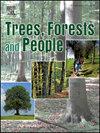Estimation of height and aerial biomass in Eucalyptus globulus plantations using UAV-LiDAR
IF 2.7
Q1 FORESTRY
引用次数: 0
Abstract
The lack of precise methods for estimating forest biomass results in both economic losses and incorrect decisions in the management of forest plantations. In response to this issue, this study evaluated the effectiveness of using the DJI Zenmuse L1 LiDAR, mounted on a DJI Matrice 300 RTK UAV, to provide three-dimensional measurements of canopy structure and estimate the aboveground biomass of Eucalyptus globulus. Various LiDAR metrics were employed alongside field measurements to calibrate predictive models using multiple regression and machine learning algorithms. The results at the individual tree level show that RF is the most accurate model, with a coefficient of determination (R²) of 0.76 in the training set and 0.66 in the test set, outperforming Elastic Net (R² of 0.58 and 0.57, respectively). At the plot level, a multiple regression model achieved an R² of 0.647, highlighting LiDAR-derived metrics as key predictors. The findings revealed that the combination of LiDAR with advanced statistical techniques, such as multiple regression and Random Forest, significantly improves the accuracy of biomass estimation, surpassing traditional methods based on allometric equations. Therefore, the use of LiDAR in conjunction with machine learning represents an effective alternative for biomasss estimation, with great potential in such plantations and contribute to more sustainable exploitation of timber resources.

利用无人机-激光雷达估算蓝桉人工林高度和空中生物量
由于缺乏估算森林生物量的精确方法,造成了经济损失和人工林管理中的错误决策。针对这一问题,本研究评估了安装在大疆matrix 300 RTK无人机上的大疆Zenmuse L1激光雷达对蓝桉树冠结构进行三维测量和估算地上生物量的有效性。各种激光雷达指标与现场测量一起使用多元回归和机器学习算法校准预测模型。在个体树水平上的结果表明,RF是最准确的模型,在训练集和测试集的决定系数(R²)分别为0.76和0.66,优于Elastic Net (R²分别为0.58和0.57)。在地块水平上,多元回归模型的R²为0.647,突出了激光雷达衍生指标作为关键预测因子。结果表明,激光雷达与先进的统计技术(如多元回归和随机森林)相结合,显著提高了生物量估算的准确性,超过了基于异速生长方程的传统方法。因此,将激光雷达与机器学习结合使用代表了生物量估算的有效替代方案,在此类种植园中具有巨大潜力,并有助于更可持续地开发木材资源。
本文章由计算机程序翻译,如有差异,请以英文原文为准。
求助全文
约1分钟内获得全文
求助全文
来源期刊

Trees, Forests and People
Economics, Econometrics and Finance-Economics, Econometrics and Finance (miscellaneous)
CiteScore
4.30
自引率
7.40%
发文量
172
审稿时长
56 days
 求助内容:
求助内容: 应助结果提醒方式:
应助结果提醒方式:


